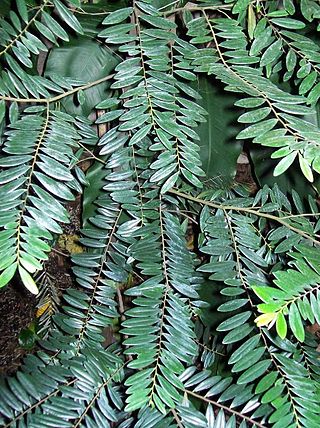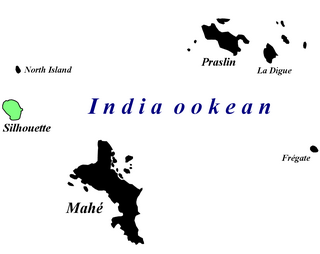The Seychelles palm frog is a species of frog that is endemic to Silhouette Island in the Seychelles. It is closely related to Gardiner's frog, Sechellophryne gardineri.

The Seychelles skink also known as the Mangouya, is a species of skink in the family Scincidae. It is endemic to the Seychelles.

Phoenicophorium, the thief palm, is a monotypic genus of flowering plant in the family Arecaceae. The sole species is Phoenicophorium borsigianum.

Thomasset's Seychelles frog or Thomasset's frog is a species of frog in the family Sooglossidae. It is endemic to Seychelles. There are two known populations: one on Silhouette Island and one on Mahé Island.

Phelsuma astriata, the Seychelles (small) day gecko or stripeless day gecko is a species of lizard in the family Gekkonidae endemic to the Seychelles.
Trilepisium gymnandrum is a species of Trilepisium that is endemic to the Seychelles, where it is threatened by habitat loss. Its natural habitat is subtropical or tropical moist lowland forests. Five mature individuals are known in two sub-populations in the mid to high altitude forests of Silhouette Island. The 18th century populations of the larger Mahé and Praslin islands have presumably been extirpated.

Trilepisium, the urnfigs or false-figs, is a small Afrotropical genus of plants in family Moraceae. They grow to medium-sized or large trees that occur in evergreen and semi-deciduous forests, flooded forests or forest patches and often along rivers and streams, and at elevations of up to 2,000 m and over.

Diospyros seychellarum, locally known as bwa sagay, is a rare endemic plant from the Seychelles. It occurs on the islands of Mahé, Praslin, Silhouette and Felicite. It is locally known as bwa sagay.

The tiger chameleon, also known as the Seychelles tiger chameleon, is the only species in the resurrected genus Archaius. Initially placed into Chamaeleo, it was for some time moved to the genus Calumma by some. It is an endangered species of chameleon, found only on the Seychelles islands of Mahé, Silhouette and Praslin.
Afrogarypus seychellesensis is a species of pseudoscorpions that is endemic to Praslin in the Seychelles. It is only known from its type specimen, and has not been seen since. If it is still extant, it would be threatened by the habitat deterioration caused by invasive plants.
Anatemnus seychellesensis is a species of pseudoscorpions that is endemic to the Seychelles, and is known from a single specimen from Silhouette Island. It is threatened by habitat degradation from invasive plants and coastal development.
Argyrodella is a monotypic genus of Seychelloise comb-footed spiders containing the single species, Argyrodella pusillus. It was first described by Michael I. Saaristo in 2006, and is found on the Seychelles.
Argyrodes rostratus is a species of tangle-web spider that is endemic to the Seychelles, and can be found on Mahé, Île Sèche, Cerf, Conception, Silhouette, Curieuse, Cousin, Aride, Praslin, La Digue, Grand Sœur, Felicite, Marianne, Denis islands and the Alphonse and St. François atolls. It is found in woodland, shrubby habitat and gardens, and is a kleptoparasite of red-legged golden orb-web spiders. It is threatened by habitat deterioration due to invasive plants, especially Cinnamomum verum.
Hasarius rufociliatus is a species of jumping spiders. The species is endemic to four islands in Seychelles: Curieuse, Mahé, Silhouette and Felicite.

The Seychelles frog is a species of frog endemic to Mahé, Silhouette and Praslin islands in the Seychelles. It inhabits the floor of damp rainforest at altitudes from 150 m (490 ft) to 991 m (3,251 ft) above sea level. Higher altitude sites are considered to be more climatically stable and more suitable. The species is present in Morne Seychellois National Park, Silhouette National Park and Praslin National Park.

Seycellesa is a genus of spiders in the family Theridiidae. It consists of only its type species: Seycellesa braueri, which is endangered and endemic to the Seychelles.
Seselphisis visenda, the Seychelles predatory bush-cricket, is a species of cricket first described by Bolivar in 1912. It is a member of the family Tettigoniidae in the order Orthoptera. It is found in the forests of the islands of Mahé, Silhouette, Praslin and La Digue in the Seychelles.

Afrolychas braueri, commonly known as the Seychelles forest scorpion, is a species of scorpion in the family Buthidae. It is currently thought to survive only on Silhouette Island, Seychelles, although the species was historically found on two additional Seychellois islands. This scorpion lives in leaf litter in forests that are largely unaffected by invasive plant species. It is a small yellowish-brown scorpion with three prominent keels on the dorsal surface of its mesosoma, which distinguishes it from other scorpions. While not much is known about the Seychelles forest scorpion's ecology due to the paucity of sightings, it is known to rely solely on its venom to capture its prey and defend its young. Its venom is not dangerous to humans.
Carausius scotti, or Scott's stick insect, is an insect species endemic to Silhouette Island in the Seychelles. It was assessed as critically endangered in The IUCN Red List of Threatened Species in 2007 as a restricted range species with an area of occupancy of 10 square kilometres (3.9 sq mi) with an estimated extent of occurrence (EOO) of 18 square kilometres (6.9 sq mi). The species is primarily threatened with declining woodland habitats due to invasive plants and also climactic factors such as droughts. It is present in the protected area of Silhouette National Park as a part of conservation efforts, however more conservation actions are needed, as well as further research to determine population sizes and trends.
Delosia ornata is a species of cockroach in the family Ectobiidae. It is endemic to Desroches Island in Seychelles.










